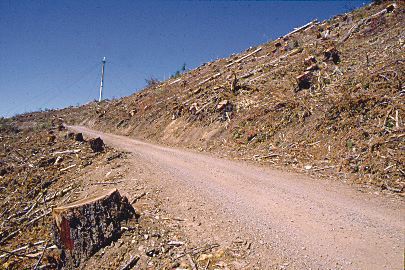In 1990, one Forest Service economist, Richard Haynes, predicted,
"You'll probably see all of the big companies leave the Northwest region."1 Two
economists have shown that the major timber companies have been reducing
their mill capacities in the Northwest and increasing their mill
capacity in the Southeast.2 As well, large timber corporations, always on the lookout for timber, are clearcutting overseas, particularly in Siberia, Central
America, Brazil and the Far East.
Historically, the timber corporations have tended to overcut a region
and then move on, leaving behind economically devastated areas. The timber
frontier in this country moved from Maine to Pennsylvania, from
Pennsylvania to the Great Lakes, from the Great Lakes to the Southeast.

The national forests were off limits to logging, grazing and mining when
they were first established in 1891. It was not until 1897, due to
pressure from timber interests, that public lands were opened up to commercial
logging. For decades, logging levels in the National Forests were low,
only a few billion board feet per year nationwide. Early on the Forest
Service banned clearcutting on federal lands, insisting that loggers take only
mature trees and leave the smaller ones standing. The Forest Service
actually criticized the timber industry's destructive logging practices
on privately owned land.5 Yet, little was done by Congress or the Forest
Service to end the logging practices they had condemned.
The end of the 19th Century also saw one of the biggest public land
giveaways in U.S. history, with the federal government agreeing to allow
large railroads rights to use of huge tracts of federal lands for
development of transnational railways.
In their remarkably detailed book describing this historical action,
"Railroads and Clearcuts", Derrick Jensen, George Draffen, and Dr. John
Osborn, relate the following, "In 1864 President Lincoln signed into
law the largest of the railroad land grants, the Northern Pacific railroad land
grant. This law conditionally granted public lands for the purpose of
building and maintaining a railroad from Lake Superior to the Pacific
Ocean. The law gave public lands for a railroad right-of way upon which to lay
the tracks and 40 million acres (an area slightly smaller than Washington
state) to raise capital need to build and maintain the railroad. The land was
granted in alternating square miles, which created a "checkerboard"
pattern of ownership that is still visible on maps of many Pacific Northwest
forests."6
In 1870, after Northern Pacific failed to move ahead on the project,
Congress revised the grant. "Railroads and Clearcuts" explains, "If
Northern Pacific failed financially, then it was to sell the remaining grant
lands at local auction. In any case, all lands were to opened to homesteaders
within five years of completing the railroad. In 1873 and again 1893, Northern
Pacific failed financially, but the lands were never legitimately sold
at local auction, Ultimately, millions of acres of railroad forests would
pass from Northern Pacific to Weyerhaeuser and other corporations."
Most of this land fell to the chainsaw.
"Railroads and Clearcuts" describes how these millions of acres of
public lands were stolen by the railroad companies, destroyed through clearcut
logging and how we continue to this day to see a large amounts of these
"land-grant logs, cants, and wood chips bypass local mills and
opportunities for value-added industries" in the Pacific Northwest.7
Often, large corporations have built their empires, their profits and
their environmentally destructive legacy by buying illegally acquired public
property at land grab rates and destroying these lands through excessive
logging. These practices have imperiled hundreds of species of plants
and animals that rely on native forests for their survival.
Companies like Plum Creek Timber Company, Weyerhaeuser, Boise Cascade
and Champion International have liquidated millions of acres of forests in
the Pacific Northwest that rightly should have been publicly controlled.
Weyerhaeuser, alone, purchased 900,000 acres of Northern Pacific grant
lands in Washington state in 1899. The effect of the Northern Pacific land
grant was still being felt in the 1970s when Champion International bought
about 670,000 acres of these lands in Montana in 1972. After clearcutting most of this land, Champion sold it to Plum Creek
Timber Company in 1993.8 Conservationists continue to work to keep these lands
from being clearcut.

